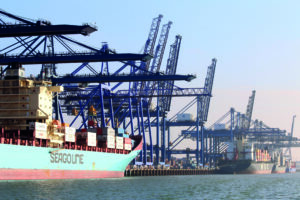The International Maritime Organization is at the forefront of decarbonizing the shipping industry. E&H Marine asks whether sufficient progress is being made, and fast enough, to meet the IMO’s ambitious targets.
In 2018, the International Maritime Organization (IMO) – a specialized agency of the United Nations formed in 1948 to regulate shipping – adopted its Initial Strategy to really tackle the industry’s greenhouse gas emissions. And the framework didn’t shy away from setting definitive targets.
“One of the main goals is to reduce the total annual GHG emissions by at least 50% by 2050 compared with 2008, which means a significant reduction in carbon intensity for individual ships,” explains Roel Hoenders, the IMO’s acting head of air pollution and energy efficiency. “At the same time, IMO is pursuing efforts to phase out GHG emissions from shipping entirely, as soon as possible within this century.”
The organization also executes international cooperation projects with its member states, particularly developing countries, to implement energy efficiency in the shipping sector.
The IMO already applies mandatory measures to vessels in order to reduce emissions through a range of technical and operational means. Examples include mandated efficiency levels for ships, tools to improve vessel performance, and required aggregation and submission of all fuel oil consumption data to the IMO.
But while progress continues, there is plenty of work to be done, Hoenders explains.
“It is likely that further measures will need to be adopted in the short and medium term to meet the targets set out in the strategy,” he admits. “In particular, IMO member states are currently considering a set of binding amendments to the MARPOL Convention [IMO’s pollution prevention treaty] with the objective to reduce carbon intensity of international shipping [CO2 emissions per transport work], by at least 40% by 2030, compared with 2008, with expected approval before the end of this year.”

Choose your own path
While the IMO develops and adopts measures, it is governments that have the remit and responsibility to ensure implementation. This means that the shipping sector as a whole must find ways to adjust in line with mandatory requirements. Furthermore, IMO regulations are technologically agnostic, without championing any one solution.
“For example, IMO’s mandatory Energy Efficiency Design Index (EEDI) requirements constitute a performance-based mechanism based on a formula expressed in grams of CO2 per capacity-mile,” Hoenders explains. “But it leaves a choice of technologies to attain the required energy efficiency level – new engine technologies, reduction of power, use of wind-assisting devices and so on. This is a good example of how regulation can drive innovation. In the end, on such technical matters, the compliance has to be certified by the flag state or by classification societies recognized by the flag state.”
This means that any and all alternative fuel types are on the table – the strategy sees technological innovation as key to complete decarbonization, but remains open-minded regarding the exact pathway. However, the speed at which this technological innovation needs to take effect, Hoenders stresses, cannot be overstated.
“While research into developing zero-carbon marine fuels is currently underway – with electricity, hydrogen, ammonia and biofuels considered viable options – more action is needed to speed up this process. This requires huge investment, notably in R&D and infrastructure development.
“To achieve this, IMO is stepping up its efforts to act as the global forum and promoter of R&D in zero-carbon marine fuels, bringing together interested stakeholders, from the public and private sectors, but also private and development banks and other potential donors from around the world. In this context, we look forward to the discussions that will take place during the next Marine Environment Protection Committee [MEPC] on the ambitious proposal on the International Maritime Research and Development Board [IMRB].”
With a range of propulsion technologies under consideration, Hoenders believes it’s tough, at this moment, to predict which will likely come to dominate.
“We cannot foresee with high certainty the composition of the future fuel mix of shipping. Some potential fuels are still in the early development phase; therefore, technology demonstrators are needed to fully ensure their feasibility, scalability, safety and effectiveness.
“It is probable, however, that shipping’s future fuel mix will be more diversified than it is today, with more fuels potentially produced from renewable electricity and green hydrogen, biomass or fossil fuels with carbon capture and storage and other technologies. Depending on the evolution of the global energy system, it is possible that one of these sources will dominate the maritime market, but today there is too much uncertainty to know which pathway will be taken by the shipping industry.”
The bigger picture
Developing zero-emissions technology involves challenges that are, Hoenders believes, well known (but not limited) to the marine industry. Off the top of his head, he cites a few of the potential barriers to wider uptake: the size and weight of current battery technology; limitations of hydrogen-based fuel, biofuels and biogas; concerns over fuel availability; establishment of the requisite regulatory frameworks; and the need to stimulate R&D efforts while reducing risk for first adopters. But he also highlights three other challenges that are of particular interest to the IMO.
“The first is the complexity and the political sensibility of this global issue, involving many stakeholders with different interests and views,” he begins. “In this regard, IMO is probably the only forum with enough legitimacy and experience to reach ambitious global compromise on the climate issue for shipping.”
The second challenge Hoenders points to is the importance of leaving nobody behind.
“Decarbonizing a global industry such as shipping requires globally adopted solutions, in particular if we consider that more than 60% of total global trade is made between developing countries. This is the reason why IMO puts a lot of energy into establishing and supporting projects and partnerships such as the Sustainable Maritime Transport [SMART] training program in collaboration with the Republic of Korea.”
Finally, he believes there is a need for additional cooperation within and beyond the shipping sector, including stakeholders such as ports, public and private finance institutions, and the energy sector.
“Many initiatives from private stakeholders have been developed in recent years, and the International Maritime Organization also contributes to this through initiatives such as the Global Industry Alliance partnership.”
Land and sea
The shipping sector’s approach to complete decarbonization, however, is about more than just technological innovation.
“Candidate mid-term measures in the IMO strategy include incentivizing, also sometimes called market-based measures,” says Hoenders. “Such measures, including fuel taxes, for example, can have two benefits: they contribute to bridging the price gap between current carbon-intensive fuel oils and alternative low-carbon fuels, and their revenues can be used to fund concrete R&D initiatives. So these types of measures could be discussed, developed and potentially adopted – complementary to technical and operational requirements.”
Political and operational cooperation is also key, Hoenders believes, and the IMO encourages voluntary collaboration between the shipping and port sectors.
“This can contribute notably to reducing GHG emissions through actions such as the development of onshore power supply facilities, the promotion of port incentive schemes, the optimization of port calls and of ‘just-in-time’ practices, as well as others.”
The myriad factors at play within the shipping industry make widespread change a daunting prospect. The driving force needed to coordinate and motivate the many and varied stakeholders needs to come from
a central body – a role that the IMO seems tailor-made to fill. And although progress is encouraging, meeting targets that will yield meaningful decarbonization means the marine sector cannot afford to let up.

Keeping it real
It’s one thing to simply outline targets and strategies, but meeting them is the most important thing. A key aspect is ensuring that such targets are challenging, yet feasible.
“IMO is an intergovernmental body made up of member states,” explains Roel Hoenders. “Of course, the industry is represented through observer NGO delegations and it is important that their views are heard. We also need to hear from technical bodies who can advise on what is feasible.”
Examples of some of the NGOs that have consultative status at the IMO include the Institute of Marine Engineering, Science & Technology, the International Association of Classification Societies and the Royal Institution of Naval Architects.
The IMO’s approach to balancing achievability with ambition also ensures that such regulations are future-proofed. A good example of this is the EEDI, mandatory for all new ships since July 2011.
“When adopting the EEDI, IMO member states deemed it important to have the option to adjust this regulation, taking into account the status of technological developments, in order to keep it both effective and feasible in the future,” says Hoenders. “That is why a mandatory review process was built in to the regulation.”
Safe and secure
As technology races ahead, it’s vital the decarbonization of shipping keeps pace in a safe, controlled – and regulated – way.
“Safety of life at sea is a primary concern for the IMO so of course any development of new fuels has to go hand-in-hand with consideration of any safety implications for ships,” Roel Hoenders says.
With the expected growth in alternative fuel types, there will be a need for additional guidelines to ensure safe usage.
“The IGF Code [International Code of Safety for Ships Using Gases or Other Low-flashpoint Fuels] already provides a robust framework for the safe use of low-flashpoint fuels in shipping,” Hoenders adds. “But we will probably need further regulatory development to accompany and facilitate the uptake of other new fuels.”
2023 is the magic number
The IMO’s Initial Strategy builds on progress made by the sector to date, but also provides a vital framework to ensure that momentum is maintained, including the consideration of further measures.
“The Initial Strategy provides that a revised strategy is to be adopted in spring 2023 and that this revised strategy should be subject to a review five years after its final adoption,” says Hoenders. “It seems logical for such an important document to take into account the evolution of the context and the progress made. It will be up to the IMO member states to decide how this periodic review will have to be undertaken.”



